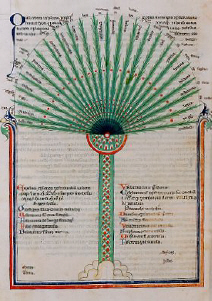The organs of touch are at the ends of the nerves, which also have the power of moving the living creature; it is there that the soul offers itself in that capacity. The nerves start in the brain [enkephalos] and it is there that people locate the principles of perception, impulse and of the whole living creature, obviously assuming that where the principles of the organs are, there is to be found what is going to use them. It would be better to say that the principle of the actualisation of the potentiality is located there; for where the source of movement in the organ resides, there must be fixed the potentiality of the workman, as it were, which is appropriate to the organ, or rather not so much the potentiality (for the potentiality is everywhere in the body) – but the principle of the actuality is where the principle of the organ is. (Ennead IV, 3, 23)
And all the senses irradiate the brain. For the power of perception is supplied from it to the sense-organs via the nerves, and when it has been injured, the senses become inactive, as doctors prove. For when what is called the protector has been placed on the meninx, the animal becomes unconscious and motionless (the meninx is the membrane protecting the brain); and when the dorsal part [sc. of the brain] has been injured, the upper part of the subject enjoys perception, while feeling disappears in the lower parts, because the power of perception is no longer supplied from the brain, as the organ, i.e. the nerve, has been injured. And if the neiwe was bound, feeling also disappears in the lower part but remains in the upper part. (Philoponus in DA 19,5-15)
When we consider the third kind of sense perception, namely hearing, we must state what the causes are by which the effects associated with it come about. In general terms let us lay it down that sound is the blow which is passed up to the soul through the ears by the air, brain and blood; and that the motion caused by the blow, beginning in the head and ending round the seat of the liver, is hearing. (Plato Timaeus 67A7-B5)
